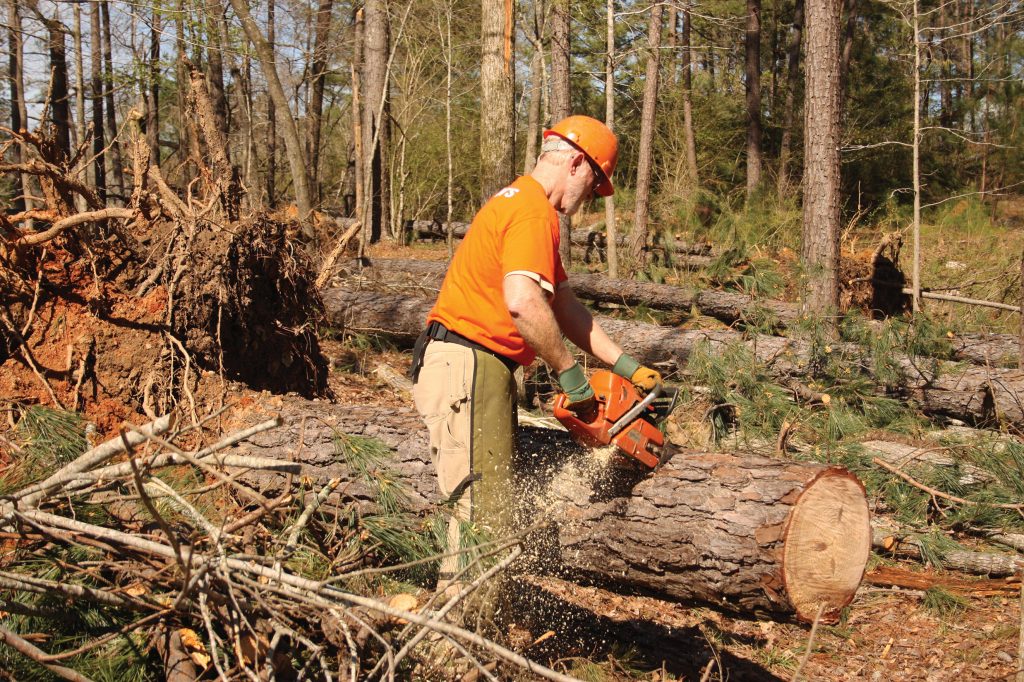Story courtesy of Alabama’s TREASURED Forests magazine, a publication of the Alabama Forestry Commission
Anyone who owns and works on their forest or farmland knows there are times you will find yourself working alone.
For all of us “do it yourselfers,” working alone can be enjoyable and rewarding. If you’re an introvert, you enjoy your own company and might rather work alone. However, keeping company with yourself can have its risks, too, and that’s in the area of safety.
In today’s world of technology, most everyone has a cell phone, GPS (Global Positioning System), or similar device on hand. However, as we all know, those devices only work if you can get a signal from a tower or can connect to the satellite. Cell service in many rural areas is spotty or non-existent, and the same is true under a closed-canopy forest. Many of us have also experienced dead or dying batteries. You might not be able to rely on an electronic device for communication or an emergency.
Some of the rangers, foresters and field associates with the Alabama Forestry Commission often work alone outdoors, sometimes for most of the day. As a result, they have developed their own checklists of things to take along or do to ensure safety on those one-man jobs. They share some of their best safety practices here:

Location, location, location
Let someone know when and where you will be working.
Establish a check-in system if you plan to be working alone for an extended period.
If you plan to work in multiple locations, leave a detailed itinerary with someone. Include such items as landmarks, addresses or GPS locations of the sites or areas you’ll be working.
Give an estimated time of arrival when you expect to return.
When you exit your vehicle, leave a note face up on the dash detailing the time you left, direction of travel, and when you plan to return. If needed, someone will know where to look for you.
When working on unfamiliar property, flag the path you take as you go along and follow it back out as you leave.
If you’re unfamiliar with the property, carry a compass and a map. That way, you won’t have to rely on your cell phone (and it’s possibly dying batteries).
If you happen to get lost, find and follow a road, creek, old fire break, forest road, utility right-of-way, etc. They all lead somewhere, and you can orient yourself or find help from there.
Communication
Have redundant communication methods. A cell phone and two-way radio are good choices. A sports whistle or small air horn are good tools for signaling for help, especially if you’re hurt.
The horn on your vehicle is also an effective way to signal for help.
Situational awareness
Always be aware of your surroundings.
When you arrive at the site where you’re going to work, look around for hazards. Is there a leaning tree or overhanging limbs that might be unsafe? Mitigate any problems before you begin.
Look around the ground for loose rocks, slick leaves, slick moss or pine straw that may affect your footing.
When crossing streams or creeks, watch for slick rocks, moss or mud. It may be wiser to walk up or downstream to find a better place to cross. The same goes for deep ditches and gullies.
Always be on the lookout for snakes, fire ants, wasps, hornets, yellow jackets and other critters and creepy-crawlies. Also look for poison ivy, poison oak and poison sumac.
Park your vehicle in a location as close to your work site as safely possible. Consider parking your vehicle pointing out; that will make it easier to leave quickly in case of an emergency.
Always be prepared
Plan your work event and bring any tools or equipment you may need to do the job safely.
Make sure all your tools and equipment are in working order before you begin the job at hand.
Bring everything plus a little extra of essentials, such as fuel, oil, blades or saw chains, saw sharpener, etc.
Carry personal protective equipment (PPE), such as snake leggings, hard hat, leather gloves, safety goggles, insect repellant, etc.
Always keep a first-aid kit on hand.
If you’re allergic to plants or insects, carry Benadryl, an Epipen or other medication.
In summer, wear light-colored clothing and wear a sun hat. Spray clothing and any cloth or canvas gear you’ll carry with you before you leave the house or office; insect repellants need time to work.
In winter, dress in layers so that you can remove outer clothing if needed. Wear a cold weather cap or hat.
Bring plenty of water and snacks if you’ll be working for an extended period. If you take midday medications, bring them with you to take during a lunch break.
If the job or task requires it, establish an escape route and safety zone when you first arrive on site.
Other advice and words of wisdom
Never leave home without a light source. A flashlight in your vehicle won’t help if you’re stranded in the dark away from it. Always carry a penlight in your pocket or field pack.
A field vest, with its many zippered pockets, is a great way to carry a cell phone, pen or pencil and paper, flagging tape, a billfold, etc.
Always carry a knife. Whether a pocketknife, belt knife or multi-tool, a good knife can be the best tool you have.
Carry a lighter. If you’re hurt and alone, you can build a fire for warmth.
It gets dark in the woods faster than anywhere else, so plan ahead. If you don’t have a light and don’t plan to stay overnight, leave the work site 30 minutes before sunset.





